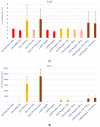The Phenolic Profile and Anti-Inflammatory Effect of Ethanolic Extract of Polish Propolis on Activated Human Gingival Fibroblasts-1 Cell Line
- PMID: 38005199
- PMCID: PMC10673102
- DOI: 10.3390/molecules28227477
The Phenolic Profile and Anti-Inflammatory Effect of Ethanolic Extract of Polish Propolis on Activated Human Gingival Fibroblasts-1 Cell Line
Abstract
Propolis, owing to its antibacterial and anti-inflammatory properties, acts as a cariostatic agent, capable of preventing the accumulation of dental plaque and inhibiting inflammation. The anti-inflammatory properties of propolis are attributed to caffeic acid phenethyl ester (CAPE), which is present in European propolis. The objective of the conducted study was to assess the anti-inflammatory effects of the Polish ethanolic extract of propolis (EEP) and isolated CAPE on stimulated with LPS and IFN-α, as well as the combination of LPS and IFN-α. The cytotoxicity of the tested compounds was determined using the MTT assay. The concentrations of specific cytokines released by the HGF-1 cell line following treatment with EEP (25-50 µg/mL) or CAPE (25-50 µg/mL) were assessed in the culture supernatant. In the tested concentrations, both CAPE and EEP did not exert cytotoxic effects. Our results demonstrate that CAPE reduces TNF-α and IL-6 in contrast to EEP. Propolis seems effective in stimulating HGF-1 to release IL-6 and IL-8. A statistically significant difference was observed for IL-8 in HGF-1 stimulated by LPS+IFN-α and treated EEP at a concentration of 50 µg/mL (p = 0.021201). Moreover, we observed that CAPE demonstrates a stronger interaction with IL-8 compared to EEP, especially when CAPE was administered at a concentration of 50 µg/mL after LPS + IFN-α stimulation (p = 0.0005). Analysis of the phenolic profile performed by high-performance liquid chromatography allowed identification and quantification in the EEP sample of six phenolic acids, five flavonoids, and one aromatic ester-CAPE. Propolis and its compound-CAPE-exhibit immunomodulatory properties that influence the inflammatory process. Further studies may contribute to explaining the immunomodulatory action of EEP and CAPE and bring comprehensive conclusions.
Keywords: caffeic acid phenethyl ester; cytokines; in vitro model; inflammation; polyphenols; propolis.
Conflict of interest statement
The authors declare no conflict of interest.
Figures












Similar articles
-
Ethanolic Extract of Propolis and CAPE as Cardioprotective Agents against LPS and IFN-α Stressed Cardiovascular Injury.Nutrients. 2024 Feb 23;16(5):627. doi: 10.3390/nu16050627. Nutrients. 2024. PMID: 38474755 Free PMC article.
-
Anti-inflammatory activity and phenolic profile of propolis from two locations in Región Metropolitana de Santiago, Chile.J Ethnopharmacol. 2015 Jun 20;168:37-44. doi: 10.1016/j.jep.2015.03.050. Epub 2015 Mar 31. J Ethnopharmacol. 2015. PMID: 25835370
-
Ethanol extract of propolis and its constituent caffeic acid phenethyl ester inhibit breast cancer cells proliferation in inflammatory microenvironment by inhibiting TLR4 signal pathway and inducing apoptosis and autophagy.BMC Complement Altern Med. 2017 Sep 26;17(1):471. doi: 10.1186/s12906-017-1984-9. BMC Complement Altern Med. 2017. PMID: 28950845 Free PMC article.
-
Caffeic acid phenethyl ester and therapeutic potentials.Biomed Res Int. 2014;2014:145342. doi: 10.1155/2014/145342. Epub 2014 May 29. Biomed Res Int. 2014. PMID: 24971312 Free PMC article. Review.
-
CAPE and Neuroprotection: A Review.Biomolecules. 2021 Jan 28;11(2):176. doi: 10.3390/biom11020176. Biomolecules. 2021. PMID: 33525407 Free PMC article. Review.
Cited by
-
The Evolution of In Vitro Toxicity Assessment Methods for Oral Cavity Tissues-From 2D Cell Cultures to Organ-on-a-Chip.Toxics. 2025 Mar 8;13(3):195. doi: 10.3390/toxics13030195. Toxics. 2025. PMID: 40137522 Free PMC article. Review.
-
The Effect of Methyl-Derivatives of Flavanone on MCP-1, MIP-1β, RANTES, and Eotaxin Release by Activated RAW264.7 Macrophages.Molecules. 2024 May 10;29(10):2239. doi: 10.3390/molecules29102239. Molecules. 2024. PMID: 38792101 Free PMC article.
-
The Potential Anti-Cancer Effects of Polish Ethanolic Extract of Propolis and Quercetin on Glioma Cells Under Hypoxic Conditions.Molecules. 2025 Jul 17;30(14):3008. doi: 10.3390/molecules30143008. Molecules. 2025. PMID: 40733274 Free PMC article.
-
The Effect of Ethanolic Extract of Brazilian Green Propolis and Artepillin C on Cytokine Secretion by Stage IV Glioma Cells Under Hypoxic and Normoxic Conditions.Pharmaceuticals (Basel). 2025 Mar 9;18(3):389. doi: 10.3390/ph18030389. Pharmaceuticals (Basel). 2025. PMID: 40143164 Free PMC article.
-
Synthesis and characterization of new electrospun medical scaffold-based modified cellulose nanofiber and bioactive natural propolis for potential wound dressing applications.RSC Adv. 2024 Aug 19;14(36):26183-26197. doi: 10.1039/d4ra04231j. eCollection 2024 Aug 16. RSC Adv. 2024. PMID: 39161434 Free PMC article.
References
-
- Kurek-Górecka A., Walczyńska-Dragon K., Felitti R., Nitecka-Buchta A., Baron S., Olczyk P. The Influence of Propolis on Dental Plaque Reduction and the Correlation between Dental Plaque and Severity of COVID-19 Complications—A Literature Review. Molecules. 2021;26:5516. doi: 10.3390/molecules26185516. - DOI - PMC - PubMed
-
- Gündogar H., Üstün K., Şenyurt S.Z., Özdemir E.Ç., Sezer U., Erciyas K. Gingival crevicular fluid levels of cytokine, chemokine, and growth factors in patients with periodontitis or gingivitis and periodontally healthy subjects: A cross-sectional multiplex study. Central Eur. J. Immunol. 2021;46:474–480. doi: 10.5114/ceji.2021.110289. - DOI - PMC - PubMed
MeSH terms
Substances
Grants and funding
LinkOut - more resources
Full Text Sources

